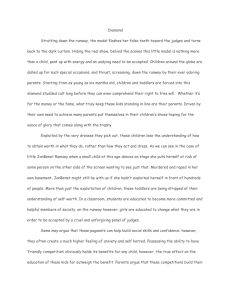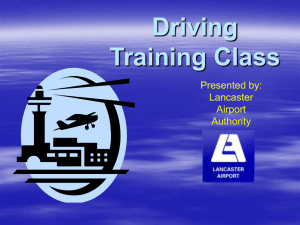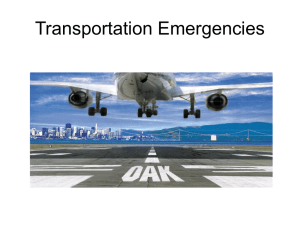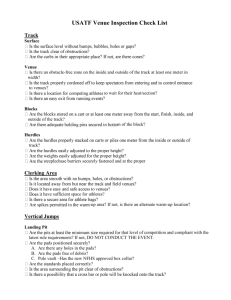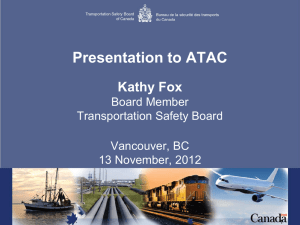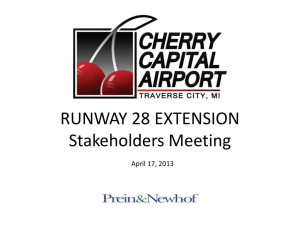AIRPORT ANNUAL DRIVER TRAINING
advertisement
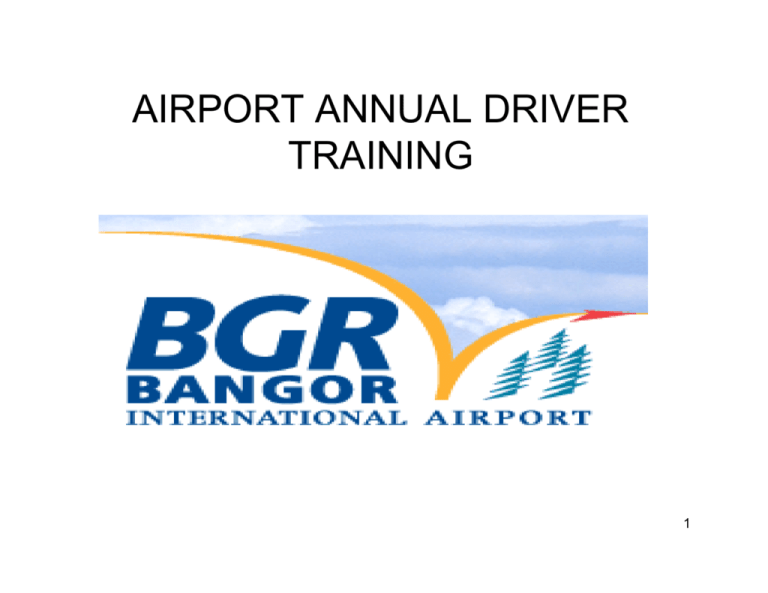
AIRPORT ANNUAL DRIVER TRAINING 1 Definitions Definitions • The Airport is divided into two areas: • Non-Movement Area • Ramps/Aprons • Non-Movement areas highlighted on next slide 3 4 5 Movement Areas -Highlighted on next slideMOVEMENT AREA The runways, taxiways, and other areas of an airport / heliport which are utilized for taxiing / hover taxiing, air taxiing, takeoff, and landing of aircraft, exclusive of loading ramps and parking areas. At those airports / heliports with a tower, specific approval for entry on to the Movement Area must be obtained fromATC. 6 7 8 9 Definitions Best Practice: Knowledge and Understanding of YOUR Runway Safety Area 250’ 500’ 1,000’ 9 27 27 1,000’ 250’ TYPICAL RUNWAY SAFETY RAMP AREA DIMENSIONS Runway Safety Area A defined prepared surface surrounding the runway. -reduces damage to aircraft in event of undershoot, overshoot or excursion from the runway. 10 Making of a Disaster The Making of a Disaster Surface Incident Definition of Surface Incident First, there must be a “surface incident.” Runway Incursion If an aircraft is involved and the “separation distance” meets the defined criteria. Surface Collision When there is NO separation during the runway incursion, the result is an accident Any event where unauthorized movement by an aircraft, vehicle, or pedestrian occurs on the Movement Area that affects or could affect the safety of flight. Fatalities 11 Runway Incursions There are 3 Types of Runway Incursions Definition of Runway Incursion Any occurrence at an airport, with an operating control tower, involving: an aircraft a vehicle a person Operational Errors Air Traffic Controllers Pilot Deviations Commercial, General Aviation & Military Vehicle & Pedestrian Deviations Airport Authority Vehicles, ARFF (Fire Trucks), Tugs, Tenants’ Personal Cars, Delivery Trucks, Pizza Delivery, Trash Trucks, Construction Vehicles, Fuel Trucks, Pedestrians, Law Enforcement, Sightseers, etc. or an object …on the ground that creates a collision hazard or results in loss of separation with an aircraft taking off, intending to take off, landing, or intending to land. 12 Definitions FOD: Foreign object debris: Trash, rocks and debris that can get sucked into the engine of an aircraft. If you see FOD on the ramp, pick it up! 13 More FOD 14 Definitions SMGCS Surface Movement Guidance Control System: A System that comprises guidance to and control or regulation of all those on an airport during low visibility operations. 15 SMGCS Procedure when plan is implemented: Access to the movement areas is solely restricted to essential vehicles, I.E.Airport Ops vehicles for emergency mtc. and inspection; Airway Facilities Vehicles for Emergency NAVAID maintenance; Follow Me vehicle to assist leading aircraft to/from parking positions, Emergency vehicles responding to an 16 emergency Definitions ILS (END OF PART 1) Signage Found at Access Points to the Runway Safety Areas Along Service Roads, BUT NOT ALWAYS. DON’T ASSUME! Instrument Landing System: Sends out an electronic signal – guides a pilot in air to end of runway Used during bad weather/low visibility 17 ILS ILS Critical Area Hold Position MARKING ILS Critical Area Hold Position Signs & Marking ENTERING the ILS Critical Area ILS Critical Area Hold Position SIGN LEAVING the ILS Critical Area Air Traffic may request that you “REPORT CLEAR OF THE ILS CRITICAL AREA.” ENTERING the ILS Critical Area ENTERING the ILS Critical Area You will see this YELLOW sign when you are LEAVING the ILS Critical Area. 18 19 20 21 ILS ILS 22 Airport Layout Runway and Taxiway Designations 24 25 Rules and Regulations Movement and Non-Movement Areas Rules and Regulations Pull up clear of the gate Block gate with vehicle until the gate closes. Do NOT drive through the gate and drive away while the gate is still open! 27 Rules and Regulations Speed Limit On Non-Movement Area 25 mph or 5mph within 100 feet of aircraft, pedestrians, buildings and gates. Lower speed during nighttime/bad weather 28 Rules and Regulations STOBES OR FLASHING LIGHTS HIGH VISIBILITY COLOR VEHICLE IDENTIFICATION Lighting On movement areas, vehicles are required to have rotating lighting on their roofs In inclement weather and and during hours of darkness, vehicles are required to use their headlights. 29 Rules and Regulations Always yield to Aircraft, unless the ATCT has given you the right of way Emergency Vehicles Pedestrians 30 Rules and Regulations Do not drive behind aircraft if it’s lights are flashing. Do not drive behind an aircraft getting pushed back. 31 Rules and Regulations If an aircraft is parked less than 100 feet away from the buildings or gates, unless you are servicing the aircraft, do not drive between the aircraft and the building/gates. Do not drive under jet bridges, or any part of an aircraft. 32 Rules and Regulations Make sure all unattended vehicles are in park Fuel trucks must be chocked If servicing an aircraft, the vehicle must be parked facing away from the aircraft. 33 Rules and Regulations The Airport has two de-icing areas. Gates 4 and 6 Tango Row 34 Deicing Areas Gates 4 and 6 Tango Row 35 Rules and Regulations Best Practice: Whenever Possible, Use of Service Roads to Remain Clear of Runways and Taxiways If you have to cross the runway, and you are not able to use the perimeter road, you MUST cross the runway at either end. Two Lane Paved 36 Rules and Regulations Whenever you escort someone in a vehicle, you must remain with them. Don’t leave them to drive on their own. Maintain Positive Control! 37 Movement Area • Signs and Markings 38 39 40 Movement area Signage Runway Location Signs Used to identify the runway on which the aircraft is located. These signs have a black background with yellow inscription and yellow borders. “BLACK SQUARE - YOU’RE THERE!” Location Sign: Yellow on Black- indicates where you are. Runway Location Signs Runway Location Sign Runway location signs are normally used where two runways intersect near the same takeoff point which could cause some confusion. 41 Movement area signage 42 Movement area signage 43 Movement area signage 44 Signs and Markings Destination Signs Black on yellow:defines the direction to take off runways-defines direction for arriving aircraft. 45 Directional Signs 46 Directional Signs 47 Taxiway Movement Area Boundary Marking Movement Side - Vehicles and Aircraft Must Have ATC Clearance to Enter NON-Movement Side NO ATC Clearance Required For Aircraft or Vehicles These markings identify the area under the control of air traffic controllers when the tower is open or operational. 1 SOLID LINE & 1 DASHED LINE Markings and Lighting Taxiway markings are in yellow Taxiway lights are blue Movement Area boundary: 1 solid and 1 dashed yellow line This separates the movement area from the non movement area You must have ATCT permission to enter the movement areas! 48 49 Taxiways 50 Taxiway Lighting Taxiway Edge Lights are Blue 51 Runways Runway Markings White Runway Edge Lines White Runway Numbers Runway Signage and Markings Runway Markings are white The runway designation will be in white on either end of the runway Runways have white edge lights ALWAYS White 52 53 54 Runway Lighting The Runway Edge Lights are White with the remaining 2000 feet Amber 55 The Last 3000 feet of Runway Center Line Lights are 2000 feet of Alternating Red and White with the Remaining 1000 feet Red 56 Extreme caution should be used in poor weather conditions if all you can see are all Red lights or all Green lights as you are within 1000 feet of the end of the runway. If you see Red you are moving towards the end, all Green and you are moving away from the end. 57 Runways The Most Important Marking on ANY Airport Usually 9 FEET Markings and Lighting Hold Position Marking: 2 solid and 2 dashed yellow lines; used in conjunction with a HOLD sign-you can not proceed beyond this line without permission from ATCT. 2 SOLID LINES & 2 DASHED LINES 58 59 60 61 STOP STOP STOP STOP STOP STOP STOP 62 Additional Help in Identifying the Runway Hold Position – During the Day….. ELEVATED RUNWAY GUARD LIGHTS Alternating Flashing Amber Lights Guard Lights-Installed at Taxiway/Runway intersections, located concurrently with the runway hold position marker. These lights help alert both pilots and vehicle operators to the entrance of a runway. 63 Runway Signage Runway Distance Remaining Sign Distance remaining Sign White on black Shows the “Runway Distance Remaining” in 1,000 foot increments. May be installed along one or both side(s) of the runway. 64 65 Radio Communications Procedures Radio Communications To enter the taxiwaysGround Control on 121.9 Who you are calling Who you are Where you are Where you are going Read back their instructions 67 Radio Communications Example of proper radio communications: “Bangor Ground, Mobile One” Mobile One is on GA ramp, request clearance onto Alpha.” When the controller responds, make sure you repeat back his instructions. Mobile One proceeding 68 onto Alpha. Radio Communications To access RunwayATCT on 120.7 Practice proper radio procedures Read back their instructions………. 69 Radio Communications Another example of proper radio communications: “Bangor Tower, Mobile One” Mobile One is on Alpha, request clearance onto the runway to conduct an inspection” Again, repeat back their instructions “Mobile One proceeding onto runway” 70 Radio Communications To re-enter the taxiway from Runways-contact ground 121.9 for permission to proceed Make sure you clear yourself the Runways to ATCT! Once you are clear of the movement area-clear yourself off to Ground121.9 “Bangor Ground, Mobile One clear of Alpha on the north end of heavy duty” 71 Radio Communications Use the correct Radio Lingo/Aviation Alphabet 72 Loss of Radio Contact Light Gun Signals Loss of Radio Contact If you lose radio communications with the tower-point your vehicle in the direction of the tower and flash your headlights If the Tower does not send someone to escort you-they will use a light gun 74 Light Gun Signals Steady Green-Okay to cross the runway/taxiway Steady Red-Stop Flashing Red-Move off the runway or taxiway Flashing White-Go back to your starting point on the Airport Alternating Red and Green-Proceed with extreme caution. 75 Non-Compliance Movement Area Regs Non-Compliance Movement Areas 1st ViolationSuspension of driving privileges for 7 days with additional training required 77 Non-Compliance 2nd ViolationSuspension of driving privileges for 14 days with additional training required. 78 Non-Compliance 3rd Violation-may result in permanent suspension of driving privileges after review by Airport Director. 79 Non-Compliance Non-Movement Area Regs Non-Compliance Non-Movement Area 1st ViolationSuspension of driving for 3 days with additional training required. 81 Non-Compliance 2nd ViolationSuspension of driving for 7 days with additional training required 3rd ViolationSuspension of driving for 14 days with additional training required. 82 Non-Compliance 4th Violation-may result in permanent suspension after review by Airport Director…. 83 Accidents Accidents Report all accidents, no matter how minor to Airport Dispatch immediately. 85 Accidents If any accident occurs on the movement and/or safety areas, and it involves an air carrier aircraft and a ground vehicle and/or pedestrian, the accident will be recorded and maintained on file in the Supt. Of Operations office for 12 consecutive calendar months from the date of the accident. 86 Accidents P ic k u p T r u c k & B - 7 4 7 T h e d r iv e r o f th is p ic k u p (s ta n d in g o u ts id e th e v e h ic le ) s a w th e 7 4 7 o n fin a l a p p r o a c h a n d r a n . T h e p ilo t r e p o r te d fe e lin g a “ s lig h t s h u d d e r ” in th e m a in g e a r u p o n la n d in g . T h e p o te n tia l fo r a n a c c id e n t is a lw a y s p r e s e n t. 87 Accidents A irp o rt A u th o rit y V e h ic le & D C -1 0 W h ile ta x iin g , th e p ilo t w a s in fo r m e d b y to w e r c o n tr o lle rs th e r e w a s a v e h ic le “ s tu c k ” u n d e r h is m a in la n d in g g e a r . T h e p o te n tia l fo r a n a c c id e n t is a lw a y s p r e s e n t. 88 Accidents S n o w B lo w e r a n d a D C -9 L o s s o f s itu a tio n a l a w a re n e s s w a s m o s t lik e ly th e p ro b a b le c a u s e a n d c e rta in ly a c o n trib u tin g fa c to r o f th is a c c id e n t. T h e s n o w b lo w e r d riv e r “ lo s t th e flic k ” a n d v e n tu re d in to a n a re a a lre a d y o c c u p ie d b y a D C -9 . L o s s o f S itu a tio n a l A w a re n e s s . 89 Accidents On Landing Roll-Out, this Cessna 210…. Hit This Ford Bronco II as it Crossed an Active Runway 90 Accidents Here’s WHY!! The Aftermath of the Deer and the Lear Airport Police Vehicle & Beech 18 91 Accidents 1 Van… 20K 1 New Wing… 500K Having Trained Drivers at Your Airport… Priceless Aircraft Towing 92 Accidents Security Vehicle Under Estimating Vehicle Clearance Height 93 Accidents P assen g er P ick-U p 94 Conclusion A Surface Incident Developed to its Fullest Potential…is a Fatal Accident !!! 95 Questions???
